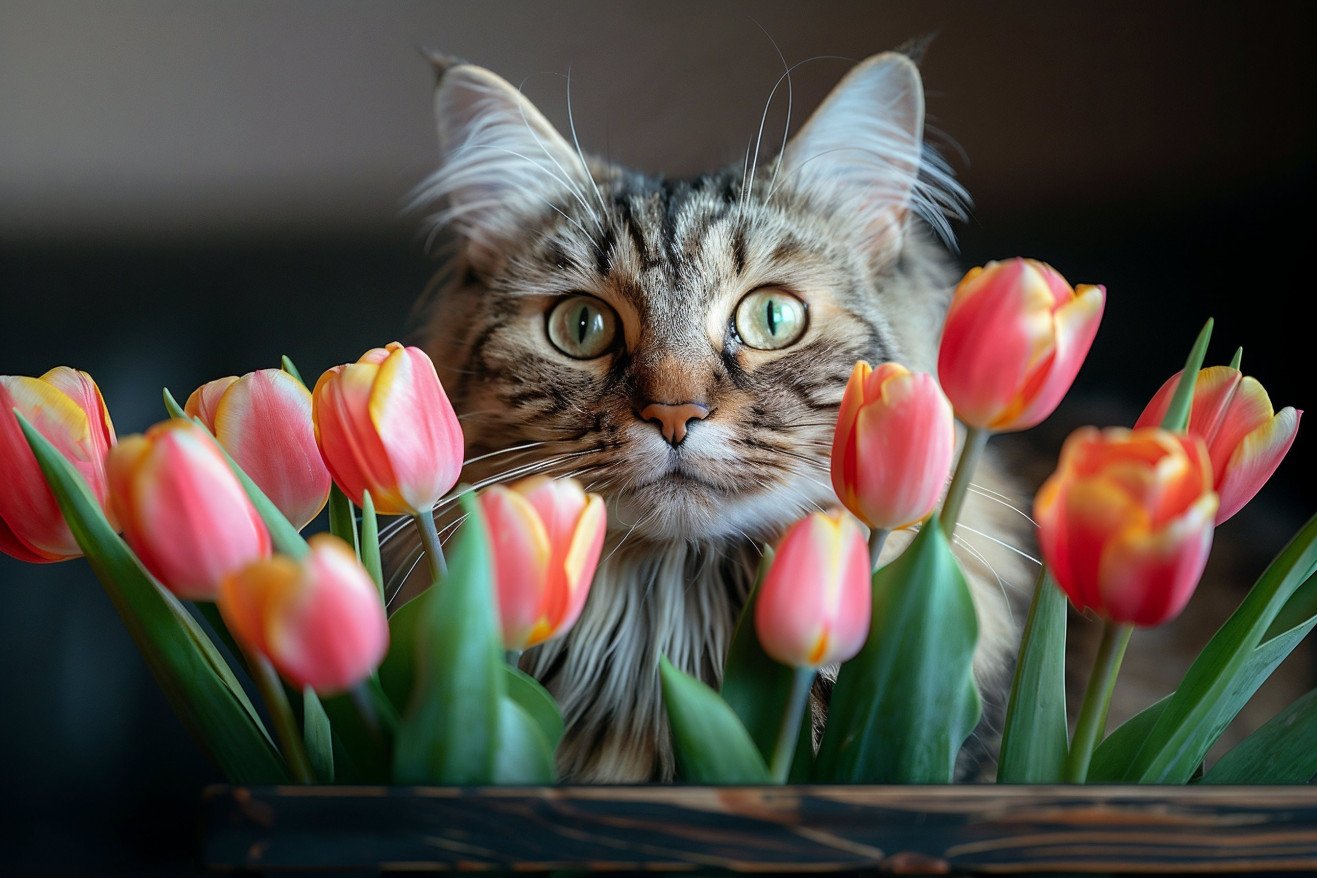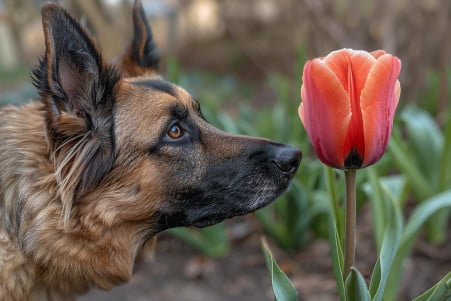Can Cats Eat Tulips? What You Need to Know About Tulip Toxicity
14 March 2024 • Updated 12 March 2024

With the arrival of spring, it’s easy to overlook the danger that tulips pose to cats. But yes, tulips are toxic to cats. All parts of the tulip plant, but especially the bulb, contain tulipalin A and B, which can lead to vomiting, diarrhea, and hypersalivation. In more serious cases, cats may experience cardiac effects and difficulty breathing. Immediate veterinary care is essential if a cat has eaten tulips.
This article offers a detailed review of the latest findings in feline health research, combining veterinary research with information from toxicology and plant biology. It covers the ways that tulips can be toxic to cats, the signs of toxicity, and what pet owners should do if they suspect their cat has eaten tulips.
The goal is to give you a comprehensive understanding of tulip toxicity and the steps you can take to protect your pets.
Are tulips poisonous to cats?
The Risks of Tulip Poisoning and Other Toxic Plants for Cats
Cats are naturally curious, and they may chew on plants for a variety of reasons, including boredom and the natural instinct to eat grass. While this behavior is normal, it can be dangerous if the plants cats have access to are toxic.
In addition to tulips, there are many other plants that can be dangerous to cats. PetMD lists Amaryllis, Autumn Crocus, and Azaleas as examples of common plants that can be toxic to cats, with symptoms that can range from vomiting and diarrhea to liver and kidney failure.
If a cat does eat a toxic plant, it’s important to act quickly. PetMD advises pet owners to remove any plant material from the cat’s mouth or coat and to confine the cat to prevent further ingestion.
Then, pet owners should contact a veterinarian or a pet poison control hotline like the Pet Poison Helpline or the ASPCA Animal Poison Control Center for advice. Treatment may involve inducing vomiting, giving activated charcoal to absorb toxins, and providing professional supportive care like intravenous (IV) fluids.
After an incident, it’s important to follow up with aftercare to ensure that the cat makes a full recovery and to prevent future incidents.
This includes following a veterinarian’s recommendations, which may include changes to the cat’s diet or medication, and taking steps to prevent future exposure to toxic plants.
The best way to protect cats from the dangers of toxic plants is to make sure that the plants in their home and garden are safe. While it’s important to be aware of the general risks of plant toxicity to cats, it’s also important to know the signs of tulip poisoning in cats so that you can respond quickly and effectively.
How to Spot the Signs: Tulip Poisoning in Cats
Despite their beauty, tulips can pose a hidden danger to your furry friend. Catster notes that if a cat has eaten tulips, it may show signs of mild gastrointestinal upset, including drooling, diarrhea, and a loss of appetite.
More worrisome symptoms include depression and vomiting. That said, the initial symptoms of tulip poisoning in cats can quickly progress to more severe issues, such as a rapid heart rate, rapid and heavy breathing, and even heart rhythm abnormalities.
When symptoms start to progress, it’s important to act fast. Since the symptoms of tulip poisoning can quickly go from mild to severe, it’s important to keep a close eye on your cat and get them to the vet at the first sign of trouble.
Dr. Bartley Harrison, DVM from The Wildest, stresses the importance of immediate veterinary care if your cat has ingested any part of a tulip. Waiting even a few hours can mean the difference between a full recovery and a life-threatening situation.
Knowing the early signs of tulip poisoning and getting help as soon as possible can help ensure your cat has the best chance of a full and speedy recovery. Knowing the toxic chemicals in tulips can help explain these symptoms, and it can also show why it’s so important to take preventative measures and act fast.
Breaking Down Tulip Toxicity in Cats
The glycosides tulipalin A and B are the toxic components of tulips that are harmful to cats. These glycosides, which are found in the highest concentration in the bulb of the plant, are responsible for causing tulip toxicity in cats.
An article explains that cats have a deficiency in their metabolic pathways that prevents them from metabolizing tulipalins. As a result, tulipalins can cause rapid and severe irritation in the mouth and gastrointestinal system when cats consume parts of the tulip, leading to clinical signs such as drooling, vomiting, and diarrhea.
The severity of a cat’s reaction to consuming a tulip is based on the part of the plant that they eat. Studies have shown that the bulb has the highest concentration of toxins and therefore poses the greatest risk. The metabolic pathways of cats don’t allow them to detoxify the tulipalins, which makes them more susceptible to the toxic effects of tulipalins.
The association between the presence of tulipalin A and B and the clinical signs that cats experience demonstrates the importance of preventing exposure and responding quickly if exposure occurs. It also helps ensure that treatment and recovery efforts are based on a solid understanding of the toxicological processes involved, enabling veterinarians to tailor their interventions to the specific issues at hand.
How to Get Through Treatment and Recovery
If you suspect that your cat has eaten tulips, it is important to get them to the vet as soon as possible. According to Catster, treatment for tulip poisoning often starts with vomiting to get the toxins out of the cat’s system. In addition, activated charcoal may be given to help absorb the toxins in the cat’s stomach. In some cases, gastric lavage may be performed to thoroughly clean out the stomach.
After treatment, supportive care is necessary. This usually involves giving the cat IV fluids to help with dehydration and symptom management, which the ASPCA says is standard. The cat’s fluid and electrolyte levels will need to be monitored, which may require an overnight or longer hospital stay until the cat is stable.
After treatment, it is important to follow your vet’s instructions to ensure that your cat makes a full recovery. It is also important to make sure that your home is safe for your cat by removing tulips and other toxic plants from areas where your cat can access them.
By taking these steps and staying on top of the situation, you can make sure that your cat doesn’t experience plant poisoning again and that they stay healthy and happy.
Cultivating Awareness: How to Prevent Plant Poisoning in Pets
Veterinarians and pet organizations are instrumental in raising awareness about plant poisonings, including those associated with tulips. The recognition of March as Pet Poison Prevention Month is an important time for these efforts. The American Society for the Prevention of Cruelty to Animals (ASPCA) offers a number of resources on poisons and pets, including lists of toxic plants and a Veterinary Lifeline Partner Program that provides immediate access to poison control experts.
Meanwhile, pet parents can take advantage of poison control hotlines and educational materials that can help them learn more about and be better prepared for potential poisonings. For example, TVM has created educational posters that emphasize the importance of the S.P.E.E.D. approach to pet poisonings, which stands for Stop the pet from eating, Phone the vet, Emergency appointment, Evidence, and Don’t delay.
At the same time, it’s important for pet parents to take steps to prevent poisonings. To pet-proof their homes and yards, pet parents can make sure that tulips and other poisonous plants are kept out of their pets’ reach or replaced with pet-friendly options. By doing so, pet parents can help ensure that all of their pets are safe from the dangers of plant poisonings.
Final Thoughts: Keeping Your Cat Safe and Tulip Poisoning
As we’ve learned, tulips can be especially dangerous to cats because of the presence of the toxic compounds tulipalin A and B. The symptoms of tulip poisoning in cats can range from mild gastrointestinal issues to severe neurological and cardiac problems, and they can quickly become more serious if not treated immediately.
In these cases, it’s important to seek out veterinary care for your cat, which could include interventions like vomiting, activated charcoal, or IV fluids.
We hope that pet parents will take advantage of the educational information provided by the ASPCA and Pet Poison Helpline to help prevent and address plant poisonings. Being informed and taking steps to protect our pets is the best way to keep them safe.
By making sure that toxic plants like tulips are kept out of our cats’ way and staying alert to the signs of poisoning, we can make sure our cats are safe and healthy.
In summary, it’s important to know the risks, be able to identify the symptoms, and act quickly to ensure that our cats stay safe and healthy. Use this information to help you protect your pets from the dangers of tulips and other poisonous plants.


